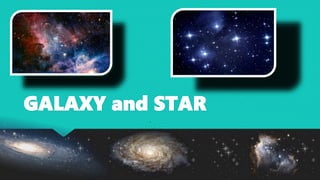
Galaxy and star
- 2. GALAXY
- 3. What is Galaxy ? A galaxy is a gravitationally bound system of stars, interstellar gas, dust, and dark matter.
- 4. Types of Galaxy There are three main types of galaxies: Elliptical Spiral and Irregular
- 5. Elliptical Galaxy Elliptical galaxies are shaped like a spheriod, or elongated sphere. In the sky, where we can only see two of their three dimensions, these galaxies look like elliptical, or oval, shaped disks Elliptical galaxies have no particular axis of rotation
- 6. Spiral Galaxy Spiral galaxies have three main components: a bulge, disk, and halo. The bulge is a spherical structure found in the center of the galaxy. This feature mostly contains older stars. The disk is made up of dust, gas, and younger stars. The halo contains old clusters of stars, known as globular clusters.
- 7. Irregular Galaxy Irregular galaxies have no regular or symmetrical structure. Having a lot of gas and dust means that these galaxies have a lot of star formation going on within them. This can make them very bright. The Large Magellanic Clouds are examples of irregular galaxies.
- 8. Milky Way Galaxy The Milky Way is a barred spiral galaxy. Milky Way is the galaxy that contains our Solar System The Milky Way is estimated to contain 100–400 billion stars. There are probably at least 100 billion planets in the Milky Way . The Milky Way consists of a bar-shaped core region surrounded by a disk of gas, dust and stars.
- 9. Whirlpool Galaxy The Whirlpool Galaxy, also known as Messier 51a, M51a, and NGC 5194. It was the first galaxy to be classified as a spiral galaxy. Its mass is estimated to be 160 billion solar masses. Overall the galaxy is about 35% the size of the Milky Way.
- 10. STAR
- 11. What is Star ? A star is a luminous ball of gas, mostly hydrogen and helium, held together by its own gravity. The nearest star to Earth is the Sun.
- 12. Different Types 0f Stars ? Protostar T Tauri Star Main Sequence Star Red Giant Star White Dwarf Star Red Dwarf Star Neutron Star Supergiant Star
- 13. Protostar A protostar is a very young star. Protostar is a collection of gas that has collapsed down from a giant molecular cloud.
- 14. T Tauri Star A very young, lightweight star, less than 10 million years old. T Tauri stars don’t have enough pressure and temperature at their cores to generate nuclear fusion.
- 15. Main Sequence Star The majority of all stars in our galaxy, and even the Universe, are main sequence stars. Our Sun is a main sequence star. Main sequence stars can vary in size, mass and brightness.
- 16. Red Giant Star A red giant is a luminous giant star of low or intermediate mass in a late phase of stellar evolution. They have radii tens to hundreds of times larger than that of the Sun.
- 17. White Dwarf Star When a star has completely run out of hydrogen fuel it becomes a white dwarf star. A white dwarf shines because it was a hot star once, but there’s no fusion reactions happening any more.
- 18. Red Dwarf Star A red dwarf is a small and relatively cool star. Red dwarfs are very-low-mass stars. As a result, they have relatively low pressures, a low fusion rate, and hence, a low temperature. Red dwarf stars are able to keep the hydrogen fuel mixing into their core.
- 19. Neutron Star Neutron stars are the smallest and densest stars known to exist. Neutron stars are created when giant stars die in supernovas and their cores collapse. At present, there are about 2000 known neutron stars in the Milky Way and the Magellanic clouds.
- 20. Supergiant Star The largest stars in the Universe are supergiant stars. They can be thousands of times bigger than our Sun and have a mass up to 100 times greater. Direct image of the star “ UY Scuti ” , a red supergiant which is one of the largest known stars.
- 21. THE END